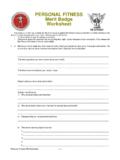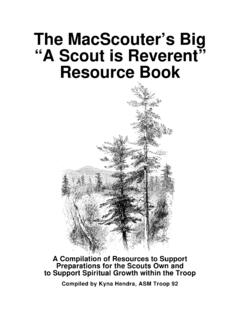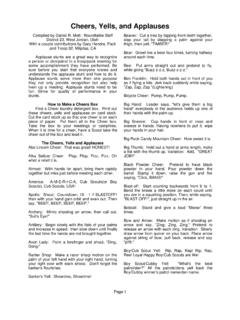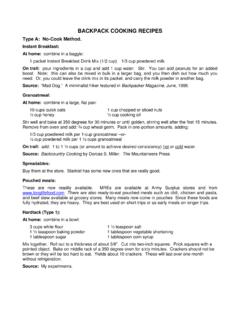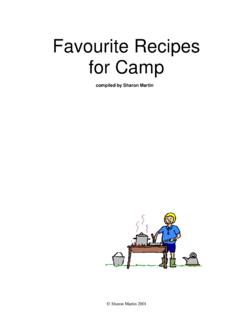Transcription of The Dutch Oven Cookbook
1 The Dutch OvenCookbookVersion -- July 1995 Original Compilation in 1990 by Mike AudlemanWith additional editing in 1994 and 1995 byJohn W. Lyver, IV, ASM, Troop 1577, Herndon, VAFor FREE Duplication Within the World Brotherhood of ScoutingScoutmaster Rule #47:"No Boy Scout ever starved to death ona weekend campout."-- Roger Morris, ScouterThe Dutch Oven Cookbook -- 2 --Audleman & LyverTable Of ContentsParagraph Title Page 1. Your Dutch Oven Can Little About the Dutch Things You Will Preparation of Your Your Few No-No' on Roast Main Stew Main Beef Main Main Main Main and Veggies and , Cookies and Reference Beans and Peas Yield Mixes and Packages and Dried Times of Spices, Herbs, Condiments and Meal Evaluation Sheet46 Appendix 1 Some Additional Recipes48 The Dutch Oven Cookbook -- 1 --Audleman & Lyver1. Introduction The reason for this book is to provide reference material for an individual who is planning orcooking a meal for six to ten people.
2 For larger groups, most of the recipes can be easily doubled ortripled and two or more Dutch ovens may be needed. Most of the information has been targeted towardthe first time Dutch oven user, although, the more experienced cook may find a tidbit or two here andthere. I hope this book will entice all of you potential Dutch oven cooks to "give 'er a try" and you will seewhy I call them "man's best friend".This book is intended to be reproduced by and for members of the World Brotherhood ofScouting. Any other use whether or not used for profit is a violation of international copyright laws. Thisbook is intended as a growing document containing Dutch Oven tips, techniques and recipes . Please letme know which recipes are good, bad or need improvement. If you wish to contribute your favoriterecipes for the next issue, please send your inputs to me at the following address and I will give you andyour troop credit in the next issue:John W.
3 Lyver, IV1382 Rock Chapel RoadHerndon, VA 22070-2059 Internet: [Unknown as of 1996] Your Dutch Oven Can DoCooking techniques such as roasting, baking simmering, stewing, frying, boiling, steaming, andmany others are easily done on the campfire with only a single utensil, the Dutch oven. Think of thepossibilities, delicious fresh baked bread that will rise up and lift the lid, cobblers made from berriespicked fresh at the campsite, incredible deep-dish pizzas, stews, quiches that melt in your mouth, Cornishgame hens roasted to perfection, and imagine a chocolate cake a foot in diameter. These and many,many more are very possible and sometimes easier than they are at home. With very few exceptions, Ihave been able to duplicate my home recipes on the campfire using the Dutch oven. All recipes use one of two Dutch oven techniques, cooking with your Dutch oven or cooking in first is when the food is placed directly in the bottom of the Dutch oven.
4 In the second method, food isplaced in a second dish and this dish is then placed onto a trivet in the bottom of the Dutch oven. Thereason for the trivet is to elevate the dish above the bottom of the oven to prevent Little About the Dutch OvenBefore we get started, we should review some of the things you will need to know beforepurchasing your first Dutch oven. There are literally hundreds of option and size combinations available,so it would be impractical for me to tell you which oven is the one for you. Because each type of oven isdesigned for a different type of cooking situation. I will go over the various options and you will have todecide which ones you will look for. In shopping for an oven, you should look for one that is obviouslywell made. Look at the bail handle, it should be of heavy gauge wire and securely attached to moldedtangs on the side of the oven.
5 ovens that have riveted tabs should be avoided. Most oven handles will laydown against the side of the oven in both directions, but if you look hard enough, you will find some thatallow the handle to stand up at a 45 degree angle on one side. This allows you easier access to it whenpositioning or removing the oven from the area that bears close examination is the handle on the lid. It should be a loop attached tothe lid on both ends and hollow in the center allowing it to be easily hooked. Stay away from the ones thathave a molded solid tab on the lid for a handle. These are very difficult to grasp and manage with a loadof coals. The loop style offers much better control. While examining the lid, check that it has a lip or ridgearound the outer edge. The lip keeps the coals from sliding off of the lid. Don't get me wrong, theridgeless ones can be used but it is difficult to keep coals on the lid and if you are not meticulous incleaning the ash from the lid each and every time you open the oven, you will end up with ash and/orsand in your food.
6 The lip virtually illuminates the problem and the lid can be lifted even fully loaded withash and coals with little Dutch Oven Cookbook -- 2 --Audleman & LyverAnother feature to look at is the legs. The most common variety is one with three legs, althoughflat-bottomed ones and four legged ones can also be had. For outdoor cooking, legs are a necessity, theymaintain the height of the oven above ground allowing air for the coals underneath. The flat bottomedones can be set up on rocks(which are scarce as hen's teeth here in Florida) or up on steel tent pegs. Ifyou figure in Murphy's Law here, the flat bottom ovens are best left in the store or on the kitchen stovewhere they were intended. I highly recommend three legs over four simply for the stability factor. It ismuch more stable with three legs sitting on rough ground than with four. The last option to look at is a second handle attached to the lid or upper rim on the oven ovens are offered with a skillet type handle attached to the lid.
7 This, in theory, is a good idea, but inreality they seem to be more in the way than of assistance. The handle does assist in using the lid upsidedown as a skillet or griddle but when using it as a lid, they get in the way of the bail handle and alsomisbalance the lid when lifting by the center hoop. They also tend to be in the way during storage andpacking situations. Fixed handles on the oven base, with one exception, should be absolutely avoided. Ibelieve the theory behind these handles was to make the oven easier to position in a deep fire pit. If youinsist on considering the handle, take a couple of red bricks with you to the store and place them in theoven. Then give her a lift by the handle and you will see the uselessness in the handle. A loaded 12" ovencan weigh 20 to 25 pounds, a real wrist breaker. The one exception is a small tab sometimes offeredwhich is about 1 to 1-1/2" deep and 2-3" wide on the upper lip of the oven.
8 This tab makes pouring liquidsfrom the oven very easy and its small size has never caused storage or packing problems for me. When someone mentions " Dutch Oven" most people immediately think "Cast Iron", but Dutchovens are supplied in aluminum also. An aluminum oven weighs only 6-1/2 to 7 pounds opposed toaround 18 pounds for the cast iron oven. There are advantages and disadvantages to each. The most obvious aluminum advantage is weight, 11 pounds lighter. Additionally, becausealuminum doesn't rust, care is restricted to simple washing with soap and water. Aluminum tends to heatfaster requiring less preheating time but they don't retain the heat very long after the coals are because aluminum reflects more heat than cast iron, more coals will be required to reach andmaintain a set temperature. Also on windy days, you will see a greater variation in temperature than oneof cast iron. Where weight is very critical, most of the disadvantages can be overcome.
9 For canoeing,backpacking or trips where weight is a problem, aluminum ovens are the careful with aluminum, it will melt! The melting point of aluminum is (cast alloy 43 is 1065 to1170 degrees F Ref Perry's Handbook of Chemical Engineering 6th edition p 23-40 Table 23-6). Otheralloys are higher melting point up to 1200 degrees F. The melting point of cast iron is 2100 degrees F to2200 degrees F (same reference). It is possible to generate that kind of temperature if the oven is indirect contact with the coals below it or if there are too many coals below the Note on Aluminum:With charcoal on and under when a strong wind came up a blast furnace effect caused thebottom to sag and the lid was dripping molten aluminum into the cake! The top held its shape, but thereare little metal balls stuck all over the inside of the lid. I always thought they were indestructible until Forsberg, SM, Troop 7, Champaign, ILAluminum is OK if properly used.
10 Keep coals from contact with the bottom of the Dutch use the number of coals needed to prepare the meal. Spread the coals below the oven out toevenly distribute the heat. Train the boys in the proper method of using an aluminum Dutch the coals below the oven out to evenly distribute the heat. Train the boys in the proper method ofusing an aluminum Dutch oven. --Ralph Romig, Scouter When weight is not a problem, the cast iron oven has the upper hand. Cast iron reacts moreslowly to temperature changes so don't burn food as easily if the fire flares up and they retain heat forquite a while after the coals have been removed, keeping food warmer longer. Also, because they retainheat well, they fair better on windy days with smaller variations in temperature. Cast iron absorbs a greatdeal of heat, consequently, they require fewer coals to reach and maintain a set temperature.


